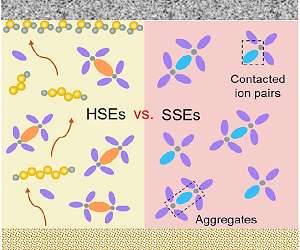The exponentially increasing implementation of renewable energy systems, such as wind and solar energy, are urgently demanding the development of large-scale energy storage devices with flexibility, high energy conversion efficiency, and simple maintenance. Among diverse candidates, due to the natural abundance and low cost of sodium reserves, sodium-ion batteries (SIBs) have recently captured widespread attention from both the academia and industry as a sustainable supplement to lithium-ion batteries (LIBs).
Non-graphitic carbons are the most promising anode candidates for SIBs. However, challenged by their variable and complicated microstructures, what is the ideal carbon anode for SIBs that can play a similar role to what graphite does in lithium-ion batteries and how to rationally design the ideal carbon anodes are fundamental but remains poorly understood. This inevitably impedes the commercialization of SIBs.
Led by Prof. Quan-Hong Yang, Dr. Jun Zhang (Tianjin University) and Prof. Yong Yang (Xiamen University), a recent study proposed sieving carbons (SCs), featuring highly tunable nanopores with the tightened pore entrance, as the practical anodes for high-energy SIBs with the extensible and reversible low-potential charge/discharge plateaus (LPPs,
This study showed that the small pore entrance diameter (
With spectroscopic and theoretical studies, an approximately linear correlation between the specific surface area in SCs and the plateau capacity was revealed, leading to a record-high plateau capacity of 400 mAh g-1.
A pore body diameter with an upper limit (~2.0 nm) was further proved to guarantee the reversibility of the LPPs, critical for enhancing the cycling stability of SC anodes. More promisingly, the reported way of preparing SCs was potential to be scalable for modifying commercial porous carbons to be practical anode materials, paving the way for the rapid commercialization of SIBs.
“The proposed sieving carbons is a conceptual advance for the carbon anode design for high-energy SIBs, and potential to play a similar role to what graphite does in lithium-ion batteries.” Prof. Quan-Hong Yang said, “The structural tunability makes sieving carbons also promising for practical use in high-energy or high-power lithium-ion batteries, potassium-ion batteries and so on.”
Research Report:Sieving carbons promise practical anodes with extensible low-potential plateaus for sodium batteries
Related Links
Tianjin University
Powering The World in the 21st Century at Energy-Daily.com
|
We need your help. The SpaceDaily news network continues to grow but revenues have never been harder to maintain. With the rise of Ad Blockers, and Facebook – our traditional revenue sources via quality network advertising continues to decline. And unlike so many other news sites, we don’t have a paywall – with those annoying usernames and passwords. Our news coverage takes time and effort to publish 365 days a year. If you find our news sites informative and useful then please consider becoming a regular supporter or for now make a one off contribution. |
||
|
SpaceDaily Contributor $5 Billed Once credit card or paypal |
SpaceDaily Monthly Supporter $5 Billed Monthly paypal only |
|

![]()
Two opposing approaches could give lithium-sulfur batteries a leg up over lithium-ion
Beijing, China (SPX) Jul 06, 2022
Lithium-sulfur batteries have for some time promised to be the successor to lithium-ion batteries, as they offer a fantastic capacity-the amount of electric charge a battery can deliver at a given voltage-at least in principle. But so far in practice, they have not at all lived up to their promise. Two opposing approaches, both aiming at reducing the volume of electrolyte required, potentially offer a pathway to solving the problem. A new review paper compares the two options and considers the applicati … read more
